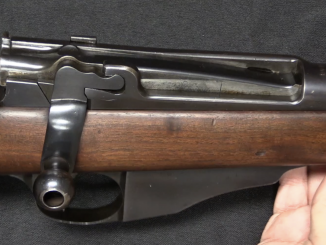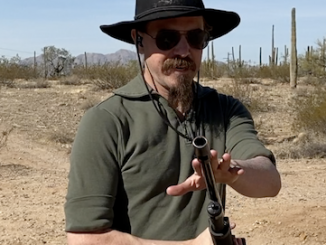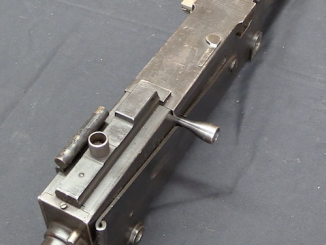With the failure of the G30M and G30R to lead to any military orders (American or otherwise), the Winchester company took the advice of the Ordnance Department to scale the design up to an automatic rifle. The BAR had a number of known shortcomings in WWII, and the military was interested in replacing it. The Winchester Automatic Rifle (WAR) offered the same basic set of features with a lighter weight and lower cost.
The WAR used a 2-lug rotating bolt like the Garand’s, in combination with a Williams short stroke gas tappet action. Chambered for the standard .30-06 cartridge and using 20-round magazines, the WAR could be used as a semiautomatic rifle or in full automatic with a rate of fire of approximately 600 rpm (slightly more or less depending on whether a muzzle device was used).
The WAR passed initial Ordnance inspection with flying colors, and a contract for 10 was placed, for more extensive testing. It passed these tests well, but they took place in the summer of 1945. By the time a major contract was a real possibility, World War II had ended, and the budget for new arms development was slashed. Had the war continued, the WAR likely would have begun to replace the BAR in US military service.




Any thoughts on how the fire selector works? I don’t think I’ve seen one that wasn’t on the side of the receiver. How does the W.A.R. compare to the M14?
The fun switch is probably similar to the disconnecter on an M14 except with the knob being at one end of the assembly rather than the other. I suppose the gizmo to engage or disengage the disconnecter assembly could, in theory, be placed at the front of the bolt or back with the fire control group. My guess is that it moved an arm down so as not to be actuated by the bolt going into battery to go semi-auto.
Putting it there looks odd, but, especially if the bi-pod was used, the weak hand could probably be used to operate it without taking the stock off the shoulder.
nick,
Based on it’s outward appearance and the fellow who designed it, check out D. M. Williams Patent No. 2461670
Interestingly, the patent claims that the design can be adjusted to vary the rate of fire.
Also, it references the following patents at the end: No. 618743 Silverman; No. 905071 Heinemann; No. 2215470 Johnson; No. 2335688 Moore; No. 2372327 Joyce; and No. 2375721 Woodhull.
Those will keep me busy for a while. ^__^
Happy reading!
I haven’t checked the patents yet
but seem to recall something similar on M3 carbines
More like comparing it to the M15. The Automatic Rifle version o the M14. Apples to apples you know ! I would think this would be preferred , though the concept of the Automatic Rifle role was already becoming obsolescent. Assault rifles , GPMGs and even SAWs were already out or being developed .
out of favor, yes, obsolescent, no
Bless you Ian, for you have solved a Memory Mystery. Many years ago I saw an photo of what were obviously World War Two GIs (Ike jackets, 1940s webbing, etc.) and one of them was holding an M14 (!) rifle. By the time the dime dropped I couldn’t find the picture leaving one to wonder if one really saw what one knows for sure one really did see (Dammit!), but can’t find the documentation to prove it, if only to yourself. Now I have the answer. Thanks again!
Sua Sponte.
It could also have been a prototype M1 that you saw. The Garand prototypes were made to used detachable 20 rounds magazines. US army tested them. Among the reasons of the removal of the box-magazine in favour of an en-bloc clip was that the magazine could be lost by the soldier (there was other and better reasons, though. But this one made me laugh).
The more I read, the more I feel that, at that time, the concept of “box magazine” was not totally understood. GB adopted Lee-Metford then Lee-Enfield because of its detachable magazine and… Provided no spare magazine. Why ? Because. No one knows (well, in fact I think someone knows…).
Garand in .276 Pedersen with 20 round BAR mags would have been the roll’s royce of infantry combat at that time…
Even a Garand with BAR Mags in .30-06 would have been a major improvement to our soldiers surviving WWII. There is no way to know just how many of our boys died because the “PING” and flying en-bloc clip gave away not only the fact that the rifle was empty, but its location as well. For someone in ordnance to argue that box magazines were not a good idea “because the soldier might lose it”, they either were a hold over from the Spanish American war who believed that “New Fangled” weapons and loading systems might encourage the Soldiers to waste ammunition; or they had investment is companies that made those en-bloc clips
Ah , that old canard raises its head– given the confusion of battle , the range at which the combatants were most likely engaged, and the sheer overwhelming noise of combat, it is unlikely that anyone could hear the ‘ping” or react to it. I doubt there were any combat losses from en-bloc clip noise.Have you had access to any reports by participants of this happening? I have seen none.
Agree
A ping might be a device to move the story line along in a novel or a movie, but that’s about it.
I don’t know how many dB the “ping” would be
but it’s far less than the 120 plus dB of the shot which came immediately before it
and the .30-06 with its loading of single base NC powder was prone to muzzle flashing, which is far more noticeable than a flying en bloc clip.
Indeed, as Keith and Vorkosigan said, that “ping problem” is a myth.
Surely, the Garand makes that noise, but in the confusion of battle, no ones cares : those few who ear it are not able to locate the exact place where it came from, and the number of shooters would have made for a melting-pot of “bangs” and “pings” punctuated by big “boums” and screams : earing that “ping” wouldn’t have meant no bullets were flying over your head at that precise moment, and there was 1 “ping” for every 8 shot fired among hundreds of shot fired.
I never read any report of a soldier about that little noise and frequently read that, precisely, it never was a problem for anyone and is just a myth.
Thibaud. Thanks for the comment, always good to hear from you. I suppose it could have been a prototype M1 but one reason I was – sure – it was an M14 was the naked barrel forward of a Garand like receiver with a short stock and hand guard. At any rate I’m going to consider the mystery solved and get a good nights sleep.
Wafa Wafa, Wasara Wasara.
The purpose of a Lee Metford magazine wasn’t to enable mag changes. It was to make the rifle easier to clean. This is why Mausers had higher rates of fire than Lee Metford/Enfields. The Mauser clip was faster to load than the Brit clip. Putting in a new mag was never an option.
The Mauser rate of fire never matched the Lee Enfield.
Thanks you for clarifying this to me, J Harlan. It was kind of obscur to me
Very cool & interesting rifles. Had never heard of them before. Too bad they never went into full production.
Only a suspicion, but it’s probable that the plunger in the front of the forend, coupled with the front sling swivel, are the keys to the takedown.
Excellent video!
M
I imagine that had the Winchester Automatic Rifle been made for the Korean War, tons of guys might have actually wanted it. This rifle would be handier and less bulky to carry than the M1918, and probably would have a shorter response time against annoying Commie snipers… Or am I wrong?
Shame that the WAR wasn’t further developed while the Korean War was rumbling, it would’ve been pretty neat and a little funny to read accounts of BAR men encountering/seeing WAR men or the automatic rifle itself for the first time.
To me you are right, I was thinking the exact same thing and it weighed only 16lb so that’s a major improvement giving the fact that the B.A.R. Weighed somewhere around 20lb . And it sure did caught my eye when I saw it and now I want one so badly that I’m already doing some hard research to see if anyone has ever some how got one that way I could make an offer, and just by me saying that is proof enough to show that many many other GIs would also want one back in the Korean War or even heck Vietnam…
I think WAR Gunner would make for the coolest sounding military role ever?
Just thinking of all the corny names sends me into a giggle fit.
WARrior
WAR thunder
WARning shot
The list goes on and on and I freaking love it.
And if you were in the National Guard you could be a Weekend WARrior… still rather have a Johnson LMG but that is purely theoretical; I much prefer (and did my service) being a thousand miles downrange with an ICBM to slogging through the mud with 20 pounds of iron and walnut!
Weight saving feature of gas tappet system seems rather questionable. A very little massed gas piston capable to reach nearly to the speed of expelled bullet, will go to strike against to an overweighted slide to balance of getting required velocity to open the back of barrel with expected delay time. The lighter of gas piston, the heavier of the slide. Though this experimental rifles do not reflect this feature exactly, M1 Carabine’s slide, since formed out through long and hard experiments to get an ensured field and battle working, would be a perfect example for this strange balance.
I’ve forgotten the name of the gentleman who wrote “Episodes in the life of a gun designer”…
during the development of the M14, he covered the un -metered and the adopted metered gas pistons with the long op rods
there was no mention of looking at a Williams tappet gas system.
I’m getting the urge to look out the Williams patent, to see whether the technology was still covered at the time,
or whether the weight of the op rod, up front, might have been seen as an advantage
or perhaps the guys developing the M14 just didn’t consider the tappet idea at all
Facts rule the forms.
Hey Ian,
I recently was on vacation in Alaska and on a stop in Ketchikan I ran into a a little “museum”/gift shop that had a really eclectic collection of firearms. If interested, email me for it’s location.
I can’t see how this would have been anywhere near as effective as the BREN. With a fixed barrel the rate of fire is going to grind to a halt pretty quick.
Ian
I realize it’s too late for this particular session but I have photographs of how this rifle probably disassembles from an early Howa .30 carbine sporting rifle made in the early 1960’s. I haven’t posted on your site before so don’t know if there is a means by which to share them here. This Howa is not on our website yet.